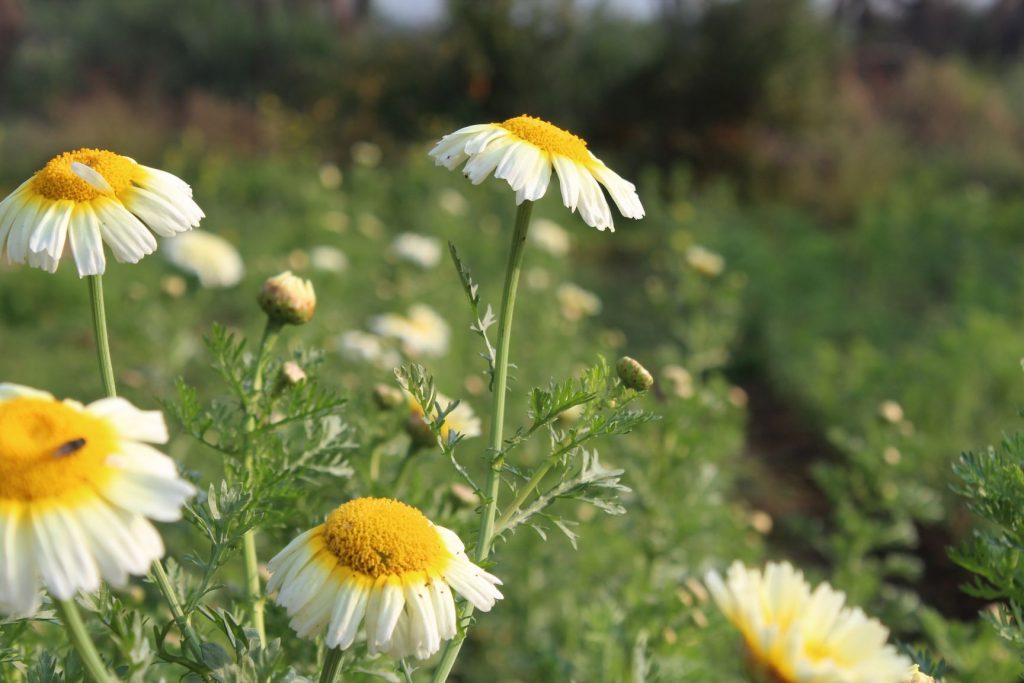Chamomile is one of the most ancient medicinal herbs known to mankind.They characteristically have yellow or white ray flowers and yellow disk flowers in compact flower heads. It is a member of the Asteraceae/Compositae family and is represented by two common varieties, German Chamomile (Chamomilla recutita) and Roman Chamomile (Chamaemelum nobile). The dried flowers of chamomile contain many terpenoids and flavonoids, which contribute to its medicinal properties.
Both the varieties of chamomile grow quickly (reaching full bloom within about 10 weeks), and are best planted in the spring, either via seed or young plants. Roman chamomile is often used as a ground cover or creeping plant to soften the edges of a stone wall or walkway, while its German counterpart is more commonly used for making tea.

How to Grow Chamomile
Chamomile is easy to start from seed. Plant the seeds about six weeks before the last expected frost. Chamomile seeds need light to germinate, so scatter the seed and press them firmly onto the soil, but do not cover the seeds with soil. Water them regularly, and they should germinate in 7-14 days. You can also direct-seed chamomile outdoors, though you’ll get better germination if you do this in the fall and let the seed stratify over winter for a spring crop.
Chamomile Care
German chamomile is an annual plant, however, it self-seeds so readily, you may think it’s a perennial just like Roman chamomile. Both are easy to care for in a garden environment and require very few extras in order to thrive. Between the two, German chamomile produces more abundant flowers, while Roman chamomile takes the medal for more fragrant blooms.
Both varieties can be used fresh off the plant, or when dried in a cool, dark environment and saved in an air-tight container (or frozen) until you’re ready to use them.
Harvest the chamomile flowers when they are fully open.


Light
Both Roman and German chamomile grow well in either full sun or partial shade. The plants will flower best in full sun, but in hot climates, a bit of partial shade is a better choice to avoid burning the delicate blooms.
Soil
Both versions of chamomile will flower best if grown in rich, organic soil. They can survive in poorer mixtures, but it will often cause their stems to be much floppier
Water
If the plant is young, water it about an inch per week. These plants are very drought tolerant once established. It’s best to allow your plants to dry out somewhat between moderate waterings.
Temperature and Humidity
Chamomile prefers a moderate temperature range between 60 to 68 degrees Fahrenheit. Because it’s drought-tolerant, it does not require special humidity considerations.
Fertilizer
Chamomile does not need fertilizer; it grows quickly without any particular need for feeding.
Common Pests
Most insects stay clear of chamomile. However, aphids and thrips can sometimes be a problem. Both can be washed off the plant or treated with insecticidal soap.


Uses
Used in everything from cosmetics to aromatherapy to beverages, calming chamomile has been around for ages, dating back thousands of years, at least to ancient Egyptian times.
Chamomile contains antioxidants that may promote sleepiness, and drinking chamomile tea has been shown to improve overall sleep quality.
Essential oils of chamomile are used extensively in cosmetics and aromatherapy.
Flower heads can also be used to make an extract that can help alleviate digestive issues.
Chamomile tea is also a remedy for many problems.
